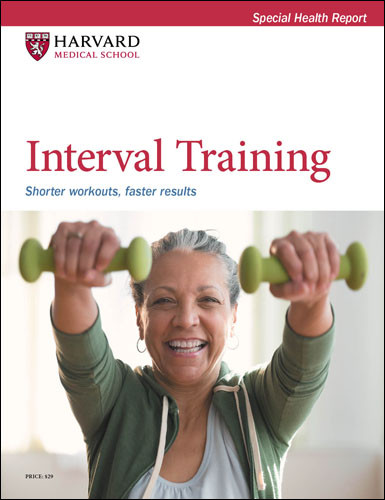An easier way to do high-intensity interval training
HIIT might be more doable — and fun — if you try it in a pool.
- Reviewed by Anthony L. Komaroff, MD, Editor in Chief, Harvard Health Letter; Editorial Advisory Board Member, Harvard Health Publishing
 By now, you're probably familiar with high-intensity interval training (HIIT), a popular workout strategy that alternates bursts of strenuous exercise with rest or lower-intensity activity. The technique helps you get fit faster than a traditional moderate-intensity workout. HIIT also produces equal or greater improvements in blood pressure, blood sugar, weight loss, and functional ability (such as walking quickly or getting out of a chair), compared with moderate-intensity exercise.
By now, you're probably familiar with high-intensity interval training (HIIT), a popular workout strategy that alternates bursts of strenuous exercise with rest or lower-intensity activity. The technique helps you get fit faster than a traditional moderate-intensity workout. HIIT also produces equal or greater improvements in blood pressure, blood sugar, weight loss, and functional ability (such as walking quickly or getting out of a chair), compared with moderate-intensity exercise.
But what if you have an old sports injury, a chronic disease, or a sedentary lifestyle that makes HIIT seem too challenging? The answer might be to perform the powerhouse workout in a pool.
Aquatic HIIT
An analysis of 18 studies published online Nov. 14, 2023, by BMJ Open Sport & Exercise Medicine found that people with chronic conditions who took part in high-intensity interval training in the water — called aquatic HIIT or AHIIT — experienced a similar boost in endurance (their maximum sustained physical exertion) as people who took part in land-based HIIT.
Almost 900 people were involved in the studies. Conditions among participants included arthritis, low back pain, lung or heart problems, peripheral artery disease, diabetes, obesity, a history of stroke, and spinal cord injury.
Water workout benefitsExercising in the water is often easier — and more fun — than exercising on land. One reason is your body's buoyancy in water. "It reduces the load on your bones and muscles. You can move more easily, and you have less fear of falling than you do on land," says Brian Simons, a physical therapist and HIIT specialist at Spaulding Rehabilitation Hospital. For more information, check out the Harvard Special Health Report Aqua Fitness. |
Getting started
While the benefits of AHIIT make it doable for people who are deconditioned or weak, it's still important to talk to your doctor before giving this strenuous workout a try, especially if you have a heart condition.
Once your doctor gives you the green light, take a gradual approach to AHIIT, depending on your current activity levels.
If you're not used to exercising: Work with a physical therapist or personal trainer to ease into an exercise routine, building up to 30-minute workouts on most days of the week. This can be a combination of working out in a pool on some days, and brisk walking on others. "For a pool workout, try leisurely swimming, walking in the pool, jumping up and down, using a kickboard and kicking across the pool, or wearing a flotation device and cycling your legs. Once your endurance improves, probably after two months, you'll be ready for AHIIT," says Brian Simons, a physical therapist and HIIT specialist at Harvard-affiliated Spaulding Rehabilitation Hospital.
If you're already a regular exerciser: Get used to exercising in a pool for a few weeks before trying AHIIT. Simons suggests seeing how well you do in different depths, and trying various pool activities mentioned above.
Diving in
You might find an AHIIT class at your health club or local YMCA. Or you can try an AHIIT program of your own making. Start with a warm-up, such as treading water for a few minutes (to get your blood flowing and muscles ready). Then, alternate intervals of intense activity and rest or leisurely activity, for a total of 30 minutes. For example:
Swim laps. Alternate periods of gentle swimming (such as swimming one very leisurely lap) with periods of intense swimming (such as swimming one or two laps as fast as you can). Repeat the process for 30 minutes.
Do a circuit. Alternate between periods of rest and a circuit of four or five exercises in a row that you do as fast as you can, for about a minute per exercise. "You could jog in place or jump up and down on the floor of the pool, scissor your arms back and forth [underwater], scissor your legs back and forth, hang on to the edge of the pool and kick hard, and then rest for a few minutes," says Simons. Repeat the process until you reach 30 minutes.
Gradually increase the length of each high-intensity period. "Ideally, we want the rest break to be shorter than the working period. But if you have a chronic condition limiting your ability, take a longer rest break," says Simons.
If AHIIT still seems too challenging, Simons offers this observation: "I've noticed that people with chronic disease develop a high level of resilience that helps them push harder than other people," says Simons. "So don't be timid. With your doctor's approval, this is something that you can do."
Image: © kali9/Getty Images
About the Author

Heidi Godman, Executive Editor, Harvard Health Letter
About the Reviewer

Anthony L. Komaroff, MD, Editor in Chief, Harvard Health Letter; Editorial Advisory Board Member, Harvard Health Publishing
Disclaimer:
As a service to our readers, Harvard Health Publishing provides access to our library of archived content. Please note the date of last review or update on all articles.
No content on this site, regardless of date, should ever be used as a substitute for direct medical advice from your doctor or other qualified clinician.
















